Did Tuition Increase Compared To 1970? College costs have soared dramatically since 1970, creating a significant financial burden for students and families; COMPARE.EDU.VN breaks down these increases, examining factors like federal funding, inflation, and public vs. private institutions to provide clarity on the rising cost of higher education, offering data-driven insights for informed decisions. Explore historical tuition rates, understand cost drivers, and make well informed choices about educational investments.
1. Introduction: The Escalating Cost of Higher Education
The escalating cost of higher education has become a major concern for students and their families. Understanding the historical trends and factors contributing to tuition increases is crucial for making informed decisions about college affordability and financial planning. compare.edu.vn offers a comprehensive analysis of tuition trends, focusing on the key question: Did tuition increase compared to 1970? We delve into the data to provide a clear picture of how college costs have changed over the decades. This guide examines public and private institutions and explores the impact of inflation and federal funding on tuition rates.
2. Tuition Trends: Public vs. Private Institutions
To effectively analyze tuition increases, it’s important to differentiate between public and private institutions. Public colleges and universities receive funding from state governments, while private institutions rely more on tuition, endowments, and donations. This difference in funding models has a significant impact on tuition rates and how they have changed over time.
| Year | Public 4-Year | Private 4-Year |
|---|---|---|
| 2022-23 | $9,750 | $35,248 |
| 2021-22 | $9,596 | $34,051 |
| 2020-21 | $9,374 | $32,728 |
| 2019-20 | $9,349 | $32,769 |
| 2018-19 | $9,212 | $31,883 |
| 2017-18 | $9,036 | $30,723 |
| 2016-17 | $8,804 | $29,476 |
| 2015-16 | $8,778 | $27,942 |
| 2014-15 | $8,543 | $26,739 |
| 2013-14 | $8,312 | $25,707 |
| 2012-13 | $8,070 | $24,523 |
| 2011-12 | $7,713 | $23,464 |
| 2010-11 | $7,132 | $22,677 |
| 2009-10 | $6,717 | $22,269 |
| 2008-09 | $6,312 | $22,040 |
| 2007-08 | $5,943 | $21,427 |
| 2006-07 | $5,666 | $20,517 |
| 2005-06 | $5,351 | $19,292 |
| 2004-05 | $5,027 | $18,604 |
| 2003-04 | $4,587 | $17,763 |
| 2002-03 | $4,046 | $16,826 |
| 2001-02 | $3,735 | $16,211 |
| 2000-01 | $3,501 | $15,470 |
| 1999-2000 | $3,349 | $14,616 |
| 1998-99 | $3,229 | $13,973 |
| 1997-98 | $3,110 | $13,344 |
| 1996-97 | $2,987 | $12,881 |
| 1995-96 | $2,848 | $12,243 |
| 1994-95 | $2,681 | $11,481 |
| 1993-94 | $2,537 | $10,952 |
| 1992-93 | $2,349 | $10,294 |
| 1991-92 | $2,117 | $9,759 |
| 1990-91 | $1,888 | $9,083 |
| 1989-90 | $1,780 | $8,396 |
| 1988-89 | $1,646 | $7,722 |
| 1987-88 | $1,537 | $7,116 |
| 1986-87 | $1,414 | $6,658 |
| 1985-86 | $1,318 | $6,121 |
| 1984-85 | $1,228 | $5,556 |
| 1983-84 | $1,148 | $5,093 |
| 1982-83 | $1,031 | $4,639 |
| 1981-82 | $909 | $4,113 |
| 1980-81 | $804 | $3,617 |
| 1979-80 | $738 | $3,225 |
| 1978-79 | $688 | $2,958 |
| 1977-78 | $655 | $2,700 |
| 1976-77 | $617 | $2,534 |
| 1975-76 | $542 | $2,291 |
| 1974-75 | $512 | $2,130 |
| 1973-74 | $514 | $2,045 |
| 1972-73 | $503 | $1,948 |
| 1971-72 | $428 | $1,832 |
| 1970-71 | $394 | $1,706 |
| 1969-70 | $358 | $1,562 |
| 1968-69 | $321 | $1,417 |
| 1967-68 | $310 | Unavailable |
| 1966-67 | $302 | Unavailable |
| 1965-66 | Unavailable | Unavailable |
| 1964-65 | Unavailable | Unavailable |
| 1963-64 | $243 | $1,011 |
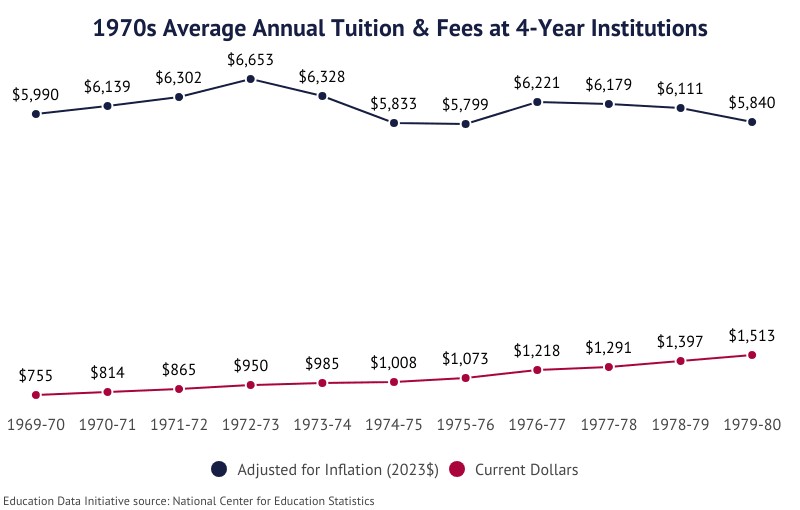
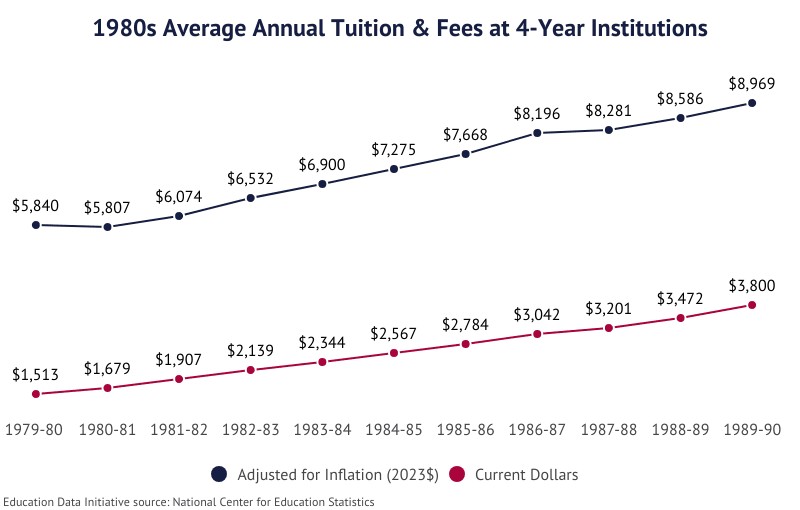
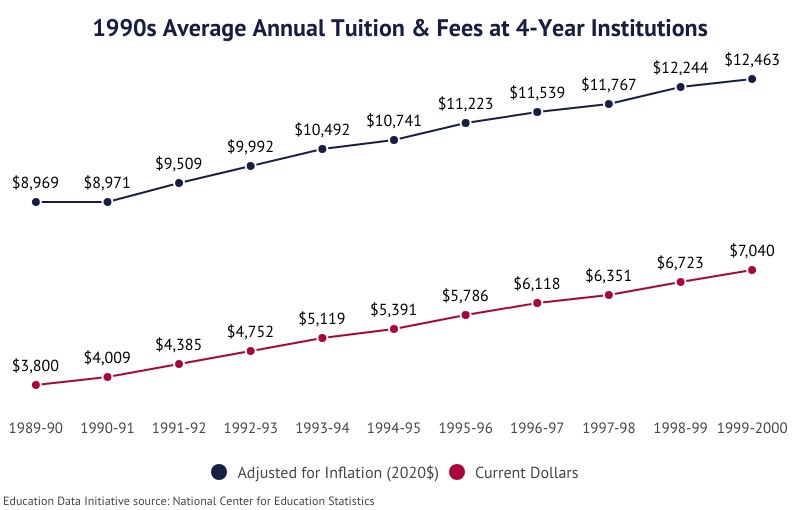
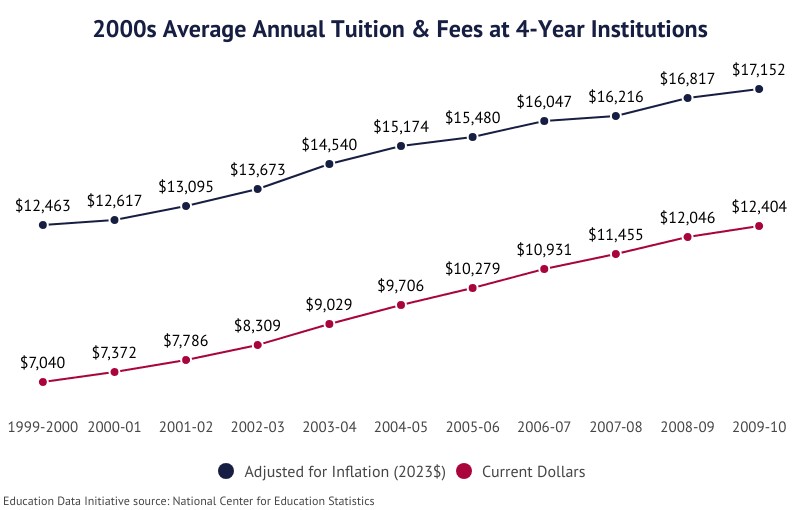
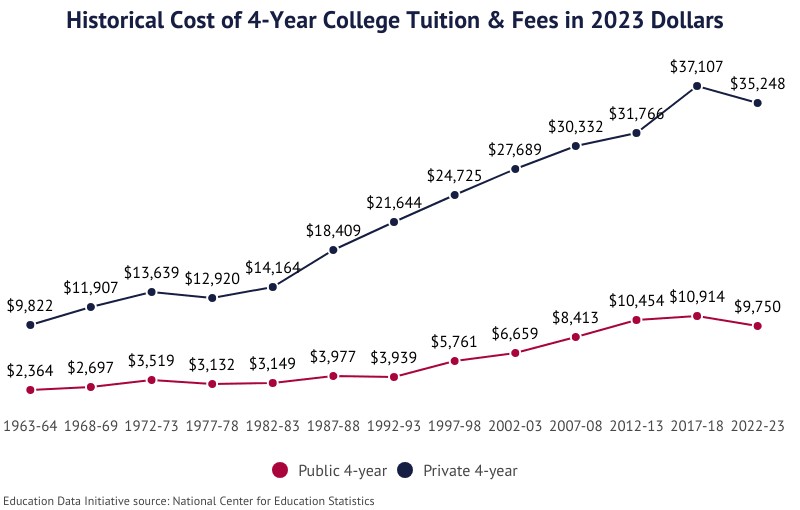
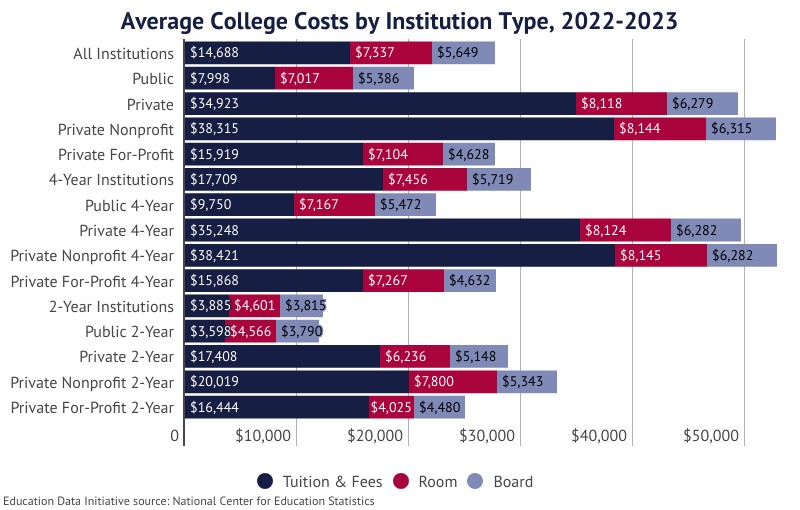
This table highlights the annual tuition and fees for both public and private four-year institutions, providing a clear view of the cost difference and the upward trend over the years.
3. Examining Tuition in the 1970s
The 1970s marked a significant turning point in the landscape of higher education costs. Several factors converged during this decade, leading to notable increases in tuition rates. This period is crucial for understanding the context of “did tuition increase compared to 1970,” as it sets the baseline for subsequent decades of rising costs.
3.1 Key Trends and Factors
Several factors contributed to the rise in tuition costs during the 1970s:
- Recession and Economic Instability: The 1970s were characterized by economic recession, with high inflation and unemployment rates. This economic instability put pressure on state budgets, leading to reduced funding for public colleges and universities.
- Federal Student Loan Programs: The expansion of federal student loan programs made college more accessible to a broader range of students. However, it also allowed institutions to increase tuition, knowing that students could finance their education through loans.
- Increased Demand for Higher Education: The demand for higher education continued to grow during the 1970s, driven by the perception that a college degree was essential for career advancement. This increased demand further fueled tuition increases.
3.2 Tuition Growth in the 1970s
The data from the 1970s clearly shows a significant rise in tuition costs at both public and private institutions:
- Public 4-Year Institutions: Between 1969-70 and 1979-80, the cost of tuition and fees at the average public 4-year institution increased from $358 to $738, an average annual increase of 7.5%.
- Private 4-Year Institutions: During the same period, tuition at private 4-year institutions grew from $1,562 to $3,225, an annual growth rate of 7.52%.
- Total Cost of Attendance: The total cost of attendance, including fees, tuition, room, and board, saw an increase of 88.0% at public 4-year schools, from $1,238 to $2,327. At private institutions, the cost of attendance grew 95.9%, from $2,559 to $5,013.
3.3 Federal Funding and Student Loans
The 1970s witnessed a substantial increase in federal funding for postsecondary education, primarily through student loan programs. This influx of funds had a complex impact on tuition costs:
- Increased Federal Budget: The federal budget for postsecondary education amounted to $3.43 billion in 1970. Throughout the decade, the federal budget increased 223%.
- Growth in Student Loans: Funding for Federal Family Education Loan (FFEL) loans increased by $3.83 billion, or 497%.
- Impact on Tuition: While the intention was to make college more affordable, the increased availability of student loans may have inadvertently contributed to tuition increases. Colleges could raise prices, knowing that students had access to more financial aid.
This graph visually represents the increase in tuition and fees during the 1970s, showing the upward trend in both public and private institutions. The availability of federal aid and loans played a significant role in enabling this growth, despite the economic hardships of the decade. This era established a pattern of rising college costs that has continued to this day, emphasizing the importance of understanding the dynamics of tuition increases.
4. College Costs in the 1980s: A Decade of Accelerated Growth
The 1980s witnessed a further acceleration in college costs, driven by a combination of factors that continued to reshape the landscape of higher education financing. Public investment in higher education declined, leading to increased reliance on tuition and student borrowing.
4.1 Declining Public Investment
One of the defining trends of the 1980s was the decline in public investment in higher education. As state governments faced budget constraints, funding for public colleges and universities was reduced, shifting the financial burden onto students and their families.
- Reduced State Funding: Many states decreased their financial support for public institutions, leading to increased pressure to raise tuition.
- Shift in Funding Model: Public colleges and universities began to operate more like private institutions, relying more on tuition revenue to cover their expenses.
4.2 Increase in Student Borrowing
As public funding declined, students and their families increasingly turned to loans to finance their education. This rise in student borrowing fueled further tuition increases, creating a cycle of debt and rising costs.
- Increased Loan Availability: Federal student loan programs continued to expand, making it easier for students to borrow money for college.
- Rising Debt Levels: As tuition costs rose, students had to borrow more money to afford college, leading to higher debt levels upon graduation.
4.3 Tuition Growth in the 1980s
The data from the 1980s shows a significant increase in tuition costs, outpacing the growth seen in the previous decade:
- Public 4-Year Institutions: Between 1979-80 and 1989-90, the average annual cost of tuition and fees at public 4-year institutions increased from $738 to $1,780, a 9.2% average annual growth rate.
- Private 4-Year Institutions: During the same period, tuition at private 4-year schools grew from $3,225 to $8,396, a 160.3% increase.
- Total Cost of Attendance: The total cost of attendance saw an increase of 113.8% at public 4-year schools, from $2,327 to $4,975. At private 4-year institutions, the cost of attendance grew from $5,013 per year to $12,284, an annual growth rate of 9.38%.
4.4 Federal Budget and Loan Funding
The federal budget for postsecondary education continued to increase during the 1980s, but the growth was not enough to offset the decline in state funding:
- Increased Federal Budget: The federal budget for postsecondary education amounted to $11.09 billion in 1980. Throughout the decade, the federal budget increased 62.9%.
- Growth in FFEL Loans: Funding for FFEL loans increased by $6.23 billion, or 135.5%.
4.5 Impact on Students and Families
The rising cost of college in the 1980s had a significant impact on students and families:
- Increased Financial Burden: Students and families had to shoulder a larger share of the cost of college, leading to increased financial stress.
- Higher Debt Levels: Graduates faced higher debt levels, making it more difficult to achieve financial stability after college.
- Access to Education: The rising cost of college threatened to limit access to higher education for low-income students.
This graph illustrates the sharp increase in tuition and fees during the 1980s, showcasing the growing financial burden on students and their families. The shift from public funding to increased reliance on student loans fundamentally altered the economics of higher education, contributing to the ongoing debate about college affordability.
5. The 1990s: The Rise of For-Profit Colleges and Continued Tuition Hikes
The 1990s introduced new dynamics to the rising costs of college, marked by the emergence of for-profit colleges and the persistent upward trend in tuition rates.
5.1 Emergence of For-Profit Colleges
The 1990s saw the rise of for-profit colleges, which took advantage of federal funding programs. These institutions often charged less for attendance than their nonprofit counterparts but became notorious for hidden expenses, poor instruction, and fraud.
- Exploitation of Federal Funding: For-profit colleges capitalized on federal student loan programs, attracting students with promises of career-oriented education.
- Controversies and Criticisms: Many for-profit institutions faced scrutiny for high tuition costs, low graduation rates, and deceptive marketing practices.
5.2 Continued Tuition Growth
Despite the presence of lower-cost for-profit options, tuition at traditional public and private institutions continued to rise during the 1990s.
- Public 4-Year Institutions: In the 1989-90 academic year, tuition at the average public 4-year institution was $1,780. By 1999-2000, it averaged $3,349, an average annual growth rate of 6.52%.
- Private 4-Year Institutions: Between 1989-90 and 1999-2000, the cost of tuition grew 74.1%, from $8,396 to $14,616.
5.3 Total Cost of Attendance
The total cost of attendance, including fees, tuition, room, and board, also increased significantly during the 1990s.
- Public 4-Year Schools: The total cost of attendance increased 66.3%, from $4,975 to $8,274.
- Private 4-Year Schools: The cost of attendance increased from $12,284 to $20,737, an annual growth rate of 5.38%.
5.4 Federal Budget and Loan Funding
The federal budget for postsecondary education continued to grow, but so did the reliance on student loans.
- Increased Federal Budget: The federal budget for postsecondary education amounted to $18.1 billion in 1990. Throughout the decade, the federal budget increased 27.3%.
- Growth in FFEL Loans: Funding for FFEL loans increased by $11.9 billion, or 110%.
5.5 Impact of Inflation
Even after adjusting for inflation, college costs increased significantly during the 1990s.
- Inflation-Adjusted Growth: After adjusting dollar values for inflation, costs increased at an average annual rate of 3.30%.
5.6 Largest YoY Increase
The largest year-over-year average tuition increase was 8.95% between the 1990-91 and 1991-92 academic years.
This graph demonstrates the sustained increase in tuition and fees throughout the 1990s, even with the emergence of for-profit colleges. The data underscores the growing financial challenges faced by students and families, setting the stage for even steeper increases in the 21st century.
6. The 21st Century: Accelerating Costs and Financial Strain
The 21st century has seen an unprecedented surge in college costs, putting immense financial strain on students and their families. Several factors have contributed to this escalation, including decreased state funding, increased demand, and rising operational expenses.
6.1 Public vs. Private Institution Costs
The gap between public and private college costs has widened significantly in the 21st century.
- Public Institutions: Public institutions have experienced substantial tuition increases due to declining state funding and increased demand.
- Private Institutions: Private institutions, while already more expensive, have also raised tuition to cover rising operational costs and maintain their competitive edge.
6.2 Tuition Growth in the 21st Century
The data from the 21st century reveals alarming trends in tuition growth:
- Public 4-Year Institutions: Between 2009-10 and 2022-23, the total cost of attendance (fees, tuition, room, and board) saw an increase of 48.9% at public 4-year schools.
- Private 4-Year Institutions: At private 4-year schools, costs grew 55.9%.
- Tuition at 4-Year Institutions: Between 1999-2000 and 2019-20, tuition at the average 4-year institution increased 136.5%, an annual rate of 4.4%.
6.3 Federal Funding and Student Aid
Federal funding for postsecondary education has increased, but it has not kept pace with the rising cost of tuition.
- Increased Federal Budget: Federal funding budgeted for postsecondary education totaled $23.0 billion in 2000. In 2010, the budget increased to $58.2 billion, an annual growth rate of 9.73% from 2000. In 2019, the budget was $107.5 billion, an annual growth rate of 7.06% from 2010.
- Impact of the CARES Act: In 2020 and 2021, the budget was $213.5 billion and $236.8 billion, respectively, heavily inflated by funding for the CARES Act.
6.4 Comparing 20th and 21st Century Costs
The escalation of academic costs in the 21st century may be slowing down, possibly below some year-over-year growth rates from the 1960s.
- Annual Growth Rate: From 1963-64 to 1968-69, academic costs increased at an average annual rate of 3.25%; that’s 19.3% faster than the increase between the 2021-22 and 2022-23 academic years.
6.5 Additional Cost Factors
Beyond tuition, other costs contribute to the overall financial burden of attending college.
- Room and Board: Between 1999-2000 and 2022-23, the annual cost of the average dorm room has increased 174.6% (54.3% with inflation). The cost of the average board or meal plan increased 124% (26.5% with inflation).
- Fees and Other Expenses: Fees for technology, student activities, and other services have also risen, adding to the financial burden.
This graph underscores the consistent rise in tuition and fees throughout the 2000s, highlighting the increasing financial pressures on students and their families. The growing gap between public and private institution costs further emphasizes the need for informed financial planning and access to affordable educational opportunities.
7. Long-Term Trends: A Historical Perspective on College Costs
To fully understand the magnitude of college tuition increases, it is essential to examine long-term historical trends. By comparing costs across different decades, we can gain valuable insights into the factors driving these changes and their impact on students and families.
7.1 Comparing Tuition Over the Decades
Let’s compare the average cost of tuition and fees at public 4-year institutions across different decades:
- 1969-70: $358
- 1979-80: $738 (106% increase from 1969-70)
- 1989-90: $1,780 (141% increase from 1979-80)
- 1999-2000: $3,349 (88% increase from 1989-90)
- 2009-10: $6,717 (100% increase from 1999-2000)
- 2022-23: $9,750 (45% increase from 2009-10)
These figures illustrate the dramatic increase in tuition costs over the past few decades. The percentage increases are particularly striking, highlighting how the rate of tuition growth has varied across different periods.
7.2 Impact of Inflation
While nominal tuition costs have increased significantly, it is important to consider the impact of inflation. Adjusting for inflation provides a more accurate picture of the real increase in college costs.
- Inflation-Adjusted Costs: Even after adjusting for inflation, college tuition has increased substantially over the long term. The real cost of attending college is significantly higher today than it was in previous decades.
7.3 The Role of Federal Funding and Student Loans
Federal funding and student loan programs have played a significant role in shaping college costs. While these programs were intended to make college more accessible, they may have also contributed to tuition increases.
- Increased Demand: The availability of federal aid and student loans has increased demand for higher education, allowing colleges to raise tuition without significantly impacting enrollment.
- Moral Hazard: Some economists argue that federal funding creates a “moral hazard,” where colleges have less incentive to control costs because students can rely on government assistance to pay for tuition.
7.4 The Impact on Affordability
The rising cost of college has had a profound impact on affordability, particularly for low- and middle-income families.
- Increased Debt Burden: Students are borrowing more money to finance their education, leading to higher debt levels upon graduation.
- Limited Access: The rising cost of college may limit access to higher education for qualified students from disadvantaged backgrounds.
This graph offers a visual representation of the historical cost of college tuition and fees, adjusted for inflation. It clearly demonstrates the significant increase in real college costs over the past few decades, highlighting the growing financial challenges faced by students and families.
8. Public vs. Private College Costs: A Detailed Comparison
Understanding the differences between public and private college costs is crucial for making informed decisions about higher education. Public and private institutions operate under different financial models, leading to significant disparities in tuition rates and overall expenses.
8.1 Funding Models
- Public Colleges and Universities: Public institutions receive funding from state governments, which helps to offset the cost of tuition. However, state funding has declined in recent years, leading to increased tuition rates.
- Private Colleges and Universities: Private institutions rely primarily on tuition revenue, endowments, and private donations. They do not receive direct funding from state governments.
8.2 Average Tuition Costs
The average tuition costs at public and private institutions vary significantly.
- Public Institutions: Annual tuition at the average public institution is $9,750.
- Private Institutions: Annual tuition at the average private institution is $34,923.
- Cost Difference: Average tuition at private institutions is 125.5% higher than tuition at public institutions.
8.3 Cost Trends Over Time
The cost trends for public and private institutions have diverged over time.
- 21st Century Tuition Growth: In the 21st century, annual tuition at the average public institution has increased 219.4%, an annual growth rate of 9.8%. During the same period, annual tuition at the average private institution has increased 130.0%, an annual growth rate of 5.19%.
- Public vs. Private Growth: Private nonprofit institutions increased tuition prices by 157.0%, while private for-profit institutions increased by 82.8%. Tuition at private nonprofit colleges increased 61.8% faster than tuition at private for-profit colleges.
8.4 Historical Comparison
Comparing tuition costs from 1963-64 until the end of the 20th century:
- Public Institutions: Annual tuition at the average public institution increased 970.1%.
- Private Institutions: Tuition at the average private college increased 1,293.3%.
- Growth Rate: In the latter half of the 20th century, private college tuition increased 28.6% faster than tuition at the average public postsecondary institution.
8.5 Factors Influencing Costs
Several factors influence the cost of attending public and private colleges.
- State Funding: Public institutions are heavily influenced by state funding levels, which can fluctuate based on economic conditions and political priorities.
- Endowments: Private institutions often have large endowments, which can help to offset tuition costs. However, the size and performance of these endowments can vary significantly.
- Prestige and Demand: Highly selective institutions, both public and private, tend to have higher tuition rates due to their prestige and high demand.
8.6 Examples
Examples of tuition costs at specific public and private institutions illustrate the cost disparities.
- University of Pennsylvania: In 1948, tuition for full-time undergraduates at U-Penn was $620, the equivalent of $8,068 in 2024 dollars. For the 2023-24 academic year, the same tuition is $66,104, representing a 719.3% increase from 1948 after adjusting for inflation.
- University of North Carolina: In the 1948-49 school year, in-state tuition for undergraduates at the public University of North Carolina was $63, the equivalent of $820 in 2024 dollars. For 2023-24, the same tuition is $4,497, representing a 448.5% increase from 1948.
This graph provides a clear visual comparison of the average college costs by institution type in 2022-23, highlighting the significant difference between public, private nonprofit, and private for-profit institutions.
9. Room and Board: Another Significant Cost Factor
In addition to tuition and fees, room and board expenses represent a significant portion of the overall cost of attending college. These costs have also increased substantially over time, adding to the financial burden on students and families.
9.1 Historical Trends
Historically, the cost of room and board could sometimes exceed the cost of tuition and fees, particularly in the first half of the 20th century.
- Early 20th Century: In the early 1900s, room and board costs often rivaled or surpassed tuition costs.
- Recent Trends: In recent decades, room and board costs have continued to rise, although tuition has generally outpaced them in terms of percentage increases.
9.2 Cost Increases
Between 1999-2000 and 2022-23, the annual cost of the average dorm room has increased significantly.
- Dorm Room Costs: The cost of the average dorm room has increased 174.6% (54.3% with inflation).
- Meal Plan Costs: The cost of the average board or meal plan increased 124% (26.5% with inflation).
9.3 Four-Year Institutions
At four-year institutions, the cost of dorm rooms and meal plans has risen substantially.
- Dorm Room Costs: Four-year institutions updated the cost of dorm rooms from $2,751 to $7,456, a 171% increase.
- Meal Plan Costs: The cost of meal plans increased from $2,558 to $5,719, a 123.6% growth.
9.4 Public vs. Private Institutions
The cost of room and board also varies between public and private institutions.
- Public 4-Year Institutions: In 2022-23, the average cost of room and board at public 4-year institutions was $12,639.
- Private 4-Year Institutions: In 2022-23, the average cost of room and board at private 4-year institutions was $14,406.
9.5 Factors Influencing Room and Board Costs
Several factors influence the cost of room and board at colleges and universities.
- Location: Colleges in urban areas or high-cost-of-living regions tend to have higher room and board expenses.
- Amenities: The availability of amenities such as private bathrooms, gyms, and dining options can also impact costs.
- Demand: High demand for on-campus housing can drive up prices.
9.6 Impact on Affordability
The rising cost of room and board can make college less affordable for students, particularly those from low-income families.
- Financial Strain: Students may struggle to afford both tuition and room and board, leading to increased financial strain.
- Alternative Housing: Some students may opt for off-campus housing to save money, but this can also present challenges, such as transportation costs and finding affordable housing options.
Average Annual Cost of Room & Board
| Year (Fall) | Public 4-Year | Private 4-Year |
|—|—|—|
| 2022-23 | $12,639 | $14,406 |
| 2021-22 | $12,236 | $13,879 |
| 2020-21 | $11,963 | $13,487 |
| 2019-20 | $11,686 | $13,162 |
| 2018-19 | $11,386 | $12,787 |
| 2017-18 | $11,012 | $12,408 |
| 2016-17 | $10,684 | $11,990 |
| 2015-16 | $10,426 | $11,592 |
| 2014-15 | $10,089 | $11,249 |
| 2013-14 | $9,787 | $10,892 |
| 2012-13 | $9,404 | $10,549 |
| 2011-12 | $9,073 | $10,213 |
| 2010-11 | $8,788 | $9,840 |
| 2009-1